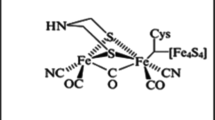Abstract
The rapid development of clean fuels for the future is a critically important global challenge for two main reasons. First, new fuels are needed to supplement and ultimately replace depleting oil reserves. Second, fuels capable of zero CO2 emissions are needed to slow the impact of global warming. This review summarizes the development of solar powered bio-H2 production processes based on the conversion of photosynthetic products by fermentative bacteria, as well as using photoheterotrophic and photoautrophic organisms. The use of advanced bioreactor systems and their potential and limitations in terms of process design, efficiency, and cost are also briefly reviewed.


Similar content being viewed by others
References
Abraham S (2002) Toward a more secure and cleaner energy future for America: national hydrogen energy roadmap; production, delivery, storage, conversion, applications, public education and outreach. U.S. Department of Energy, Washington, DC
Adams MWW (1990) The Structure and mechanism of iron-hydrogenases. Biochim Biophys Acta 1020:115–145
Andersen RA (1992) Diversity of eukaryotic algae. Biodivers Conserv 1:267
Appel J, Phunpruch S, Steinmuller K, Schulz R (2000) The bidirectional hydrogenase of Synechocystis sp. PCC 6803 works as an electron valve during photosynthesis. Arch Microbiol 173:333–338
Boichenko VA, Hoffmann (1994) Photosynthetic hydrogen-production in prokaryotes and eukaryotes—occurrence, mechanism, and functions. Photosynthetica 30:527–552
Boichenko VA, Greenbaum E, Seibert M (2004) Hydrogen production by photosynthetic microorganisms. In: Archer MD, Barber J (eds) Photoconversion of solar energy, molecular to global photosynthesis, vol. 2. Imperial College Press, London, pp 397–452
Borowitzka L (1991) Development of Western biotechnology algal beta-carotene plant. Bioresour Technol 38:251–252
Borowitzka MA (1999) Commercial production of microalgae: ponds, tanks, tubes and fermenters. J Biotechnol 70:313–321
Burgdorf T, van der Linden E, Bernhard M, Yin QY, Back JW, Hartog AF, Muijsers AO, de Koster CG, Simon P, Albracht J, Friedrich B (2005) The soluble NAD-reducing [NiFe]-hydrogenase from Ralstonia eutropha H16 consists of six subunits and can be specifically activated by NADPH. J Bacteriol 187:3122–3132
Cournac L, Guedeney G, Peltier G, Vignais PM (2004) Sustained photoevolution of molecular hydrogen in a mutant of Synechocystis sp. strain PCC 6803 deficient in the type I NADPH-dehydrogenase complex. J Bacteriol 186:1737–1746
Csogor Z, Herrenbauer M, Perner I, Schmidt K, Posten C (1999) Design of a photo-bioreactor for modelling purposes. Chem Eng Process 38:517
Dutta D, De D, Chaudhuri S, Bhattacharya SK (2005) Hydrogen production by cyanobacteria. Microb Cell Fact 4:36
Fedorov AS, Kosourov S, Ghirardi ML, Seibert M (2005) Continuous hydrogen photoproduction by Chlamydomonas reinhardtii. Appl Biochem Biotechnol 121:403–412
Franchi E, Tosi C, Scolla G, Della Penna G, Rodriguez F, Pedroni PM (2004) Metabolically engineered Rhodobacter sphaeroides RV strains for improved biohydrogen photoproduction combined with disposal of food wastes. Mar Biotechnol 6:552–565
Gaffron H (1939) Reduction of CO2 with H2 in green plants. Nature 143:204–205
Ghirardi ML, Kosourov S Tsygankov A, Seibert M (2000) Two-phase photobiological algal H2-production system. In: Proceedings of the 2000 US DOE hydrogen program review, National Renewable Energy Laboratory, Golden, Colorado, pp 1–13
Ghirardi ML, Togasaki RK, Seibert M (1997) Oxygen sensitivity of algal H2 production. Appl Biochem Biotechnol 63–65:141–151
Hallenbeck P (2005) Fundamentals of the fermentative production of hydrogen. Water Sci Technol 52:21–29
Hallenbeck P, Benemann J (2002) Biological hydrogen production; fundamentals and limiting processes. Int J Hydrogen Energy 27:1185–1193
Hoffert MI, Caldeira K, Jain AK, Haites EF, Harvey LDD, Potter SD, Schlesinger ME, Schneider SH, Watts RG, Wigley TML, Wuebbles DJ (1998) Energy implications of future stabilization of atmospheric CO2 content. Nature 395:881–884
Hofman PAG, Veldhuis MJW, Vangemerden H (1985) Ecological significance of acetate assimilation by chlorobium-phaeobacteroides. FEMS Microbiol Ecol 31:271–278
International Energy Agency (2001) World energy outlook 2001. Insights assessing today’s supplies to fuel tomorrow’s growth. Head of Publications Service, OECD, Paris
Janssen M, Tramper J, Mur LR, Wijffels RH (2003) Enclosed outdoor photobioreactors: light regime, photosynthetic efficiency, scale-up, and future prospects. Biotechnol Bioeng 81:193–210
Jouanne Y, Wong B, Vignais P (1985) Stimulation by light of nitrogenase synthesis in cells of Rhodopseudomonas capsulata growing in N limited continuous cultures. Biochim Biophys Acta 808:149–155
Koku H, Eroglu I, Gunduz U, Yucel M, Turker L (2002) Aspects of the metabolism of hydrogen production by Rhodobacter sphaeroides. Int J Hydrogen Energy 27:1315–1329
Kondo T, Arakawa M, Hirai T, Wakayama T, Hara M, Miyaye J (2002) Enhancement of hydrogen production by a photosynthetic bacterium mutant with reduced pigment. J Biosci Bioeng 93:145–150
Kruse O, Rupprecht J, Bader KP, Thomas-Hall S, Schenk PM, Finazzi G, Hankamer B (2005a) Improved photobiological H-2 production in engineered green algal cells. J Biol Chem 280:34170–34177
Kruse O, Rupprecht J, Mussgnug JH, Dismukes GC, Hankamer B (2005b) Photosynthesis: a blue print for energy capture and conversion technologies. Photochem Photobiol 4:957–970
Laurinavichene TV, Fedorov AS, Ghirardi ML, Seibert M, Tsygankov AA (2006) Demonstration of sustained hydrogen photoproduction by immobilized, sulfur-deprived Chlamydomonas reinhardtii cells. Int J Hydrogen Energy 31:659
Lee C, Chen P, Wang C, Tung Y (2002) Photohydrogen production using purple nonsulfur bacteria with hydrogen fermentation reactor effluent. Int J Hydrogen Energy 27:1309–1313
Liu H, Grot S, Logan B (2005) Electrochemically assisted microbial production of hydrogen from acetate. Environ Sci Technol 39:4317–4320
Logan BE, Grot S (2006) A bio-electrochemically assisted microbial reactor (BEAMR) that generates hydrogen gas. US Patent (pending)
Macler B, Pelroy R, Bassham J (1979) Hydrogen formation in nearly stoichiometric amounts from glucose by a Rhodopseudomonas sphaeroides mutant. J Bacteriol 138:446–452
Masojidek J, Papacek S, Sergejevova M, Jirka V, Cerveny J, Kunc J, Korecko J, Verbovikova O, Kopecky J, Stys D, Torzillo G (2003) A closed solar photobioreactor for cultivation of microalgae under supra-high irradiance: basic design and performance. J Appl Phycol 15:239–248
Melis A, Happe T (2001) Hydrogen production. Green algae as a source of energy. Plant Physiol 127:740–748
Melis A, Neidhardt J, Benemann JR (1999) Dunaliella salina (Chlorophyta) with small chlorophyll antenna sizes exhibit higher photosynthetic productivities and photon use efficiencies than normally pigmented cells. J Appl Phycol 10:515–525
Melis A, Zhang L, Forestier M, Ghirardi ML, Seibert M (2000) Sustained photobiological hydrogen gas production upon reversible inactivation of oxygen evolution in the green alga Chlamydomonas reinhardtii. Plant Physiol 122:127–136
Miyamoto K (1997) (ed) Renewable biological systems for alternative sustainable energy production. Food and Agriculture Organization (FAO), United Nations, Osaka
Miyamoto K, Nawa Y, Matsuoka S, Ohta S, Miura Y (1990) Mechanism of adaptation and H2 photoproduction in a marine green alga, Chlamydomonas sp. MGA 161. J Ferment Bioeng 70
Nath K, Das D (2004) Improvement of fermentative hydrogen production: various approaches. Appl Microbiol Biotechnol 65:520–529
Ogbonna JC, Tanaka H (2000) Light requirement and photosynthetic cell cultivation—development of processes for efficient light utilization in photobioreactors. J Appl Phycol 12:207–218
Oh S, Logan BE (2005) Hydrogen and electricity production from a food processing wastewater using fermentation and microbial fuel cell technologies. Water Res 39:4673
Oh Y, Seol E, Lee E, Park S (2002) Fermentative hydrogen production by a new chemoheterotrophic bacterium Rhodopseudomonas palustris P4. Int J Hydrogen Energy 27:1373–1379
O’Neill BC, Oppenheimer M (2002) Climate change: dangerous climate impacts and the Kyoto protocol. Science 296:1971–1972
Prince R, Kheshgi H (2005) The photobiological production of hydrogen: potential efficiency and effectiveness as a renewable fuel. Crit Rev Microbiol 31:19–31
Pulz O, Gross W (2004) Valuable products from biotechnology of microalgae. Appl Microbiol Biotechnol 65:635–648
Schutz K, Happe T, Troshina O, Lindblad P, Leitao E, Oliveira P, Tamagnini P (2004) Cyanobacterial H-2 production—a comparative analysis. Planta 218:350–359
Stal LJ, Moezalaar R (1997) Fermentation in cyanobacteria. FEMS Microbiol Rev 21:179–211
Tamagnini P, Costa JL, Almeida L, Oliveira MJ, Salema R, Lindblad P (2000) Diversity of cyanobacterial hydrogenases, a molecular approach. Curr Microbiol 40:356–361
Thomas CD, Cameron A, Green RE, Bakkenes M, Beaumont LJ, Collingham YC, Erasmus BFN, de Siqueira MF, Grainger A, Hannah L, Hughes L, Huntley B, van Jaarsveld AS, Midgley GF, Miles L, Ortega-Huerta MA, Peterson AT, Phillips OL, Williams SE (2004) Extinction risk from climate change. Nature 427:145–148
Urbig T, Schulz R, Senger H (1993) Inactivation and reactivation of the hydro-genases of the green algae Scenedesmus obliquus and Chlamydomonas reinhardtii. Z Naturforsch 48:41–45
Vasilyeva L, Miyake M, Khatipov E, Wakayama T, Sekine M, Hara M, Nakada E, Asada Y, Miyake J (1999) Enhanced hydrogen production by a mutant of Rhodobacter sphaeroides having an altered light-harvesting system. J Biosci Bioeng 87:619–624
Vignais PM, Billoud B, Meyer J (2001) Classification and phylogeny of hydrogenases. FEMS Microbiol Rev 25:455–501
Warthmann R, Cypionka H, Pfennig N (1992) Photoproduction Of H2 from acetate by syntrophic cocultures of green sulfur bacteria and sulfur-reducing bacteria. Arch Microbiol 157:343–348
Woodward J, Orr M, Cordray K, Greenbaum E (2000) Biotechnology—enzymatic production of biohydrogen. Nature 405:1014–1015
Acknowledgements
The authors would particularly like to thank Clemens Posten and Michael Borowitzka for kindly providing us with the bioreactor pictures shown in Fig. 2. GCD acknowledges support from the AFOSR-MURI grant FA9550. OK acknowledges financial support form the University of Bielefeld and BH acknowledges the financial support of the University of Queensland (UQRDG 2004001578).
Author information
Authors and Affiliations
Corresponding author
Rights and permissions
About this article
Cite this article
Rupprecht, J., Hankamer, B., Mussgnug, J. et al. Perspectives and advances of biological H2 production in microorganisms. Appl Microbiol Biotechnol 72, 442–449 (2006). https://doi.org/10.1007/s00253-006-0528-x
Received:
Revised:
Accepted:
Published:
Issue Date:
DOI: https://doi.org/10.1007/s00253-006-0528-x




